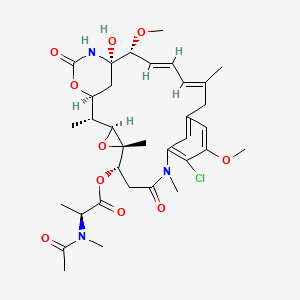| MeSH term | MeSH ID | Detail |
|---|---|---|
| Breast Neoplasms | D001943 | 24 associated lipids |
| Lung Neoplasms | D008175 | 171 associated lipids |
| Pancreatic Neoplasms | D010190 | 77 associated lipids |
| Colonic Neoplasms | D003110 | 161 associated lipids |
| Mammary Neoplasms, Experimental | D008325 | 67 associated lipids |
| Body Weight | D001835 | 333 associated lipids |
| Prostatic Neoplasms | D011471 | 126 associated lipids |
| Melanoma | D008545 | 69 associated lipids |
| Brain Diseases | D001927 | 27 associated lipids |
| Leukemia P388 | D007941 | 43 associated lipids |
MAYTANSINE
MAYTANSINE is a lipid of Polyketides (PK) class. Maytansine is associated with abnormalities such as Myelosuppression and BOSLEY-SALIH-ALORAINY SYNDROME. The involved functions are known as Mutation, Agent, Polymerization, Cell Cycle Arrest and Drug Kinetics. Maytansine often locates in Cytoplasm, Hepatic, Lysosomes, Cell surface and Microtubules. The associated genes with MAYTANSINE are ABCB1 gene, HM13 gene, CNN1 gene, CYP2C8 gene and CYP2D6 gene. The related lipids are Valerates. The related experimental models are Xenograft Model.
Cross Reference
Introduction
To understand associated biological information of MAYTANSINE, we collected biological information of abnormalities, associated pathways, cellular/molecular locations, biological functions, related genes/proteins, lipids and common seen animal/experimental models with organized paragraphs from literatures.
What diseases are associated with MAYTANSINE?
MAYTANSINE is suspected in Myelosuppression, BOSLEY-SALIH-ALORAINY SYNDROME and other diseases in descending order of the highest number of associated sentences.
Related references are mostly published in these journals:
| Disease | Cross reference | Weighted score | Related literature |
|---|
Possible diseases from mapped MeSH terms on references
We collected disease MeSH terms mapped to the references associated with MAYTANSINE
PubChem Associated disorders and diseases
What pathways are associated with MAYTANSINE
There are no associated biomedical information in the current reference collection.
PubChem Biomolecular Interactions and Pathways
Link to PubChem Biomolecular Interactions and PathwaysWhat cellular locations are associated with MAYTANSINE?
Visualization in cellular structure
Associated locations are in red color. Not associated locations are in black.
Related references are published most in these journals:
| Location | Cross reference | Weighted score | Related literatures |
|---|
What functions are associated with MAYTANSINE?
Related references are published most in these journals:
| Function | Cross reference | Weighted score | Related literatures |
|---|
What lipids are associated with MAYTANSINE?
Related references are published most in these journals:
| Lipid concept | Cross reference | Weighted score | Related literatures |
|---|
What genes are associated with MAYTANSINE?
Related references are published most in these journals:
| Gene | Cross reference | Weighted score | Related literatures |
|---|
What common seen animal models are associated with MAYTANSINE?
Xenograft Model
Xenograft Model are used in the study 'IMGN853, a Folate Receptor-α (FRα)-Targeting Antibody-Drug Conjugate, Exhibits Potent Targeted Antitumor Activity against FRα-Expressing Tumors.' (Ab O et al., 2015).
Related references are published most in these journals:
| Model | Cross reference | Weighted score | Related literatures |
|---|
NCBI Entrez Crosslinks
All references with MAYTANSINE
Download all related citations| Authors | Title | Published | Journal | PubMed Link |
|---|---|---|---|---|
| Morimura O et al. | Trastuzumab emtansine suppresses the growth of HER2-positive small-cell lung cancer in preclinical models. | 2017 | Biochem. Biophys. Res. Commun. | pmid:28526406 |
| Menderes G et al. | SYD985, a novel duocarmycin-based HER2-targeting antibody-drug conjugate, shows promising antitumor activity in epithelial ovarian carcinoma with HER2/Neu expression. | 2017 | Gynecol. Oncol. | pmid:28473206 |
| Moore KN et al. | Phase 1 dose-escalation study of mirvetuximab soravtansine (IMGN853), a folate receptor α-targeting antibody-drug conjugate, in patients with solid tumors. | 2017 | Cancer | pmid:28440955 |
| Ito K et al. | Near-Infrared Photochemoimmunotherapy by Photoactivatable Bifunctional Antibody-Drug Conjugates Targeting Human Epidermal Growth Factor Receptor 2 Positive Cancer. | 2017 | Bioconjug. Chem. | pmid:28402624 |
| Sun X et al. | Effects of Drug-Antibody Ratio on Pharmacokinetics, Biodistribution, Efficacy, and Tolerability of Antibody-Maytansinoid Conjugates. | 2017 | Bioconjug. Chem. | pmid:28388844 |
| Seidel K et al. | Synthesis of Magnetic-Nanoparticle/Ansamitocin Conjugates-Inductive Heating Leads to Decreased Cell Proliferation In Vitro and Attenuation Of Tumour Growth In Vivo. | 2017 | Chemistry | pmid:28585348 |
| Lynce F et al. | SAFE-HEaRt: Rationale and Design of a Pilot Study Investigating Cardiac Safety of HER2 Targeted Therapy in Patients with HER2-Positive Breast Cancer and Reduced Left Ventricular Function. | 2017 | Oncologist | pmid:28314836 |
| Janjigian YY and Braghiroli MI | Current Progress in Human Epidermal Growth Factor Receptor 2 Targeted Therapies in Esophagogastric Cancer. | 2017 | Surg. Oncol. Clin. N. Am. | pmid:28279471 |
| Stefan N et al. | Highly Potent, Anthracycline-based Antibody-Drug Conjugates Generated by Enzymatic, Site-specific Conjugation. | 2017 | Mol. Cancer Ther. | pmid:28258164 |
| Wang H et al. | Albumin nanoparticle encapsulation of potent cytotoxic therapeutics shows sustained drug release and alleviates cancer drug toxicity. | 2017 | Chem. Commun. (Camb.) | pmid:28195282 |
